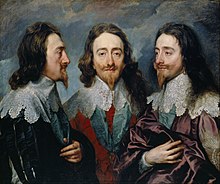Lovelock (hair)

A Lovelock was popular amongst European "men of fashion" from the end of the 16th century until well into the 17th century. The lovelock was a long lock of hair, often plaited (braided) and made to rest over the left shoulder (the heart side) to show devotion to a loved one.[1]
Origin[]
Robin Bryer, author of The History of Hair: Fashion and Fantasy Down the Ages (2003), speculates that the lovelock may have originated as an alternative to the love token worn by knights during the medieval period.[2]
Examples[]
Christian IV of Denmark (1577–1648) wore a lovelock, possibly because of a medical condition plica polonica, and others in his court copied it, making it a Danish court fashion.[3] His brother-in-law James I of England (1566–1625) wore a lovelock,[4] and at the court of his son, Charles I (1600–1649) many courtiers (including women) wore them in the French fashion (where they were called denette). Charles I can be seen wearing one in the Triple portrait by Antony van Dyck, where a large pearl can be seen suspended from the end of the lock.[2]
Criticism[]

William Prynne, a puritan pamphleteer, wrote Health's Sickness. The Unloveliness of Lovelocks (1628), in which he states that for men to wear their hair long was "unseemly and unlawful unto Christians", while it was "mannish, unnatural, impudent, and unchristian" for women to cut it short. He related the story of a nobleman who was dangerously ill, and who, on his recovery, "declared publicly his detestation of his effeminate, fantastic lovelock, which he then sensibly perceived to be but a cord of vanity, by which he had given the Devil holdfast to lead him at his pleasure, and who would never resign his prey as long as he nourished this unlovely bush", and so he ordered the barber to cut it off. Thomas Hall wrote a pamphlet The Loathsomnesse of Long Haire. ... (1654) in which he also attacked the fashion. These different views on fashion are in part reflected in the uncomplimentary nicknames the two sides gave each other during the English Civil War: the Royalists called their enemies Roundheads while the Parliamentarians called the Royalists Cavaliers.[5]
See also[]
Notes[]
- ^ Hall 2008, p. 278.
- ^ a b Dobranski 2015, p. 154.
- ^ RCIN 612170.
- ^ James was married to Anne of Denmark
- ^ Planché 1876, p. 278; Firth 1896, p. 436; Gordon 1890, p. 91
References[]
- Dobranski, Stephen (2015), Milton's Visual Imagination: Imagery in Paradise Lost, Cambridge University Press, p. 154, ISBN 978-1-316-36869-5
- Firth, Charles Harding (1896), , in Lee, Sidney (ed.), Dictionary of National Biography, 46, London: Smith, Elder & Co, p. 436
- Gordon, Alexander (1890), , in Stephen, Leslie; Lee, Sidney (eds.), Dictionary of National Biography, 24, London: Smith, Elder & Co, p. 91
- Hall, James (2008), The sinister side: how left-right symbolism shaped Western art, Oxford and New York: Oxford University Press, p. 278
- Planché, James Robinson (1876), A Cyclopaedia of Costume Or Dictionary of Dress, Including Notices of Contemporaneous Fashions on the Continent: The dictionary, Chatto and Windus, p. 246
- "RCIN 612170 - Christianvs Qvartvs dei Gratia Daniae, Norwegiae", Royal Collection, retrieved 18 February 2019
Further reading[]
- Ashdown, Mrs. Charles H. (2012), British Costume from Earliest Times to 1820, Courier Corporation, p. 418, ISBN 978-0-486-14762-8
- Human hair
- Superstitions
- Symbolism
